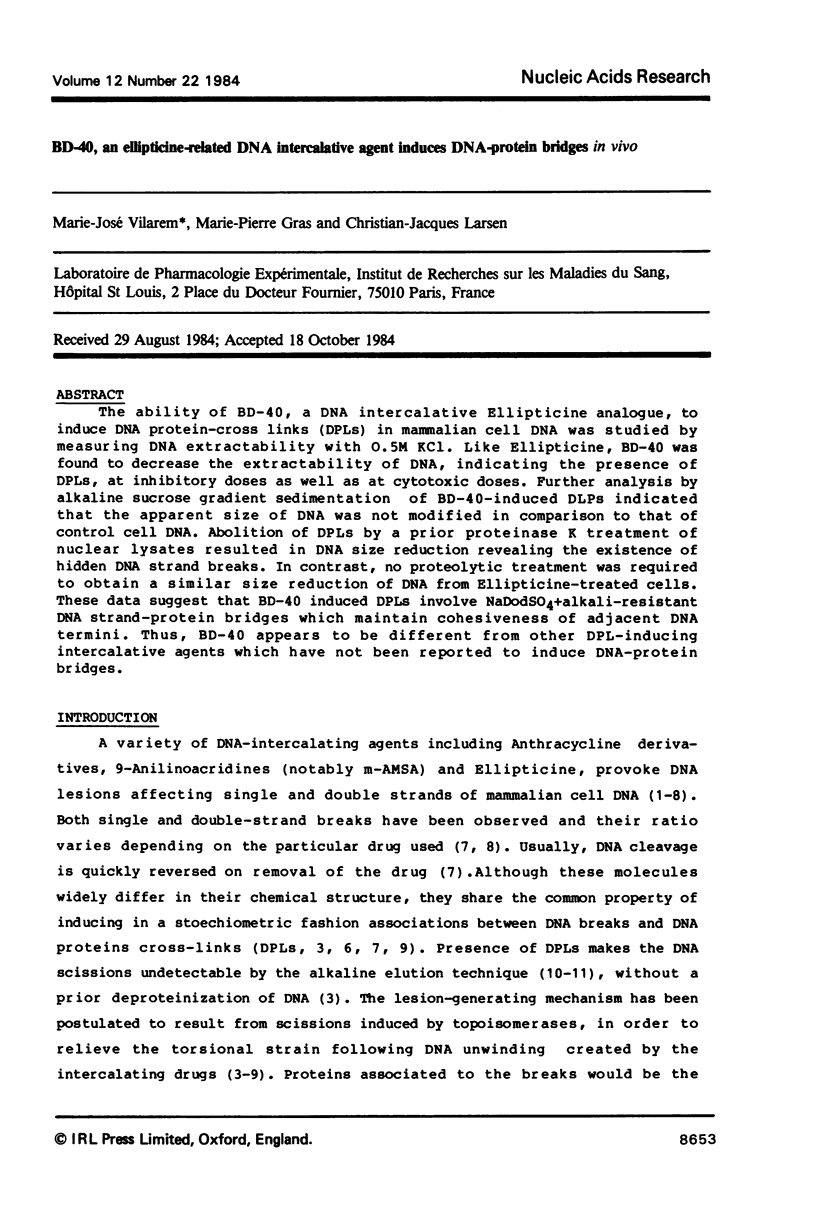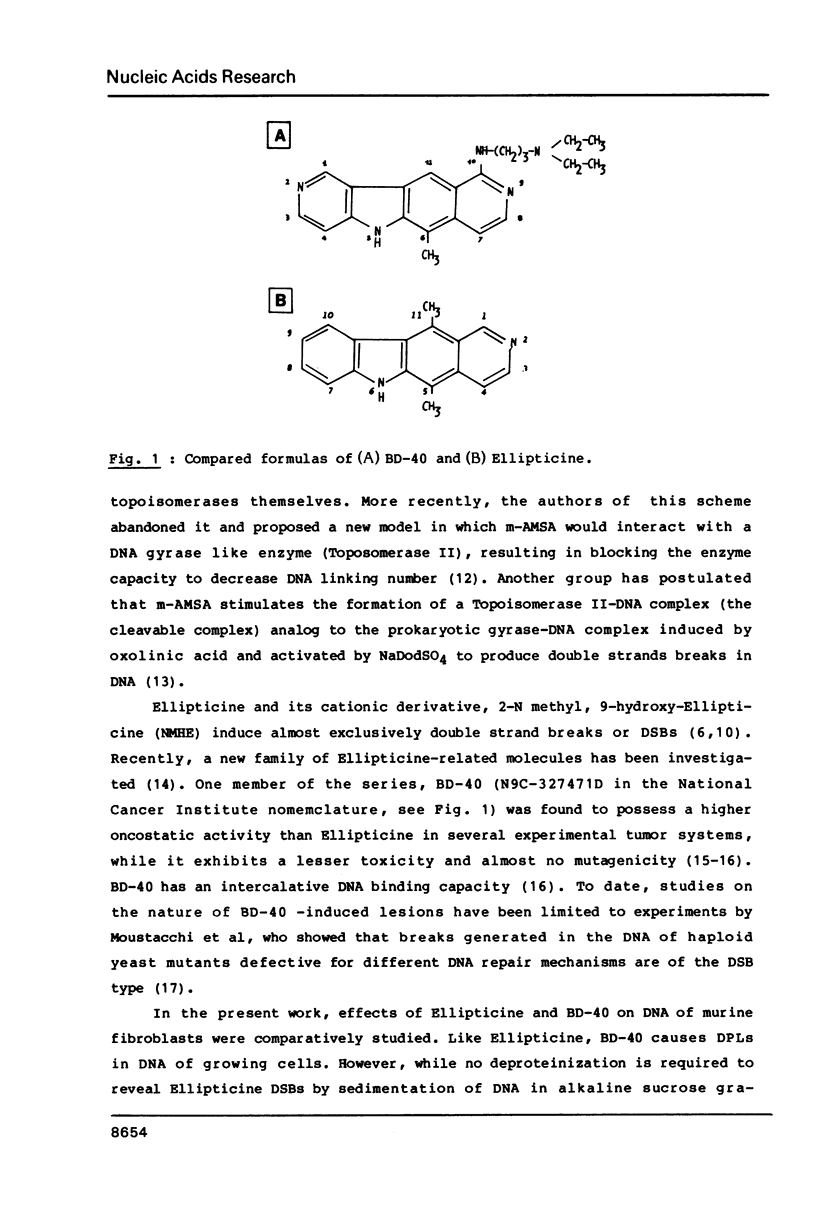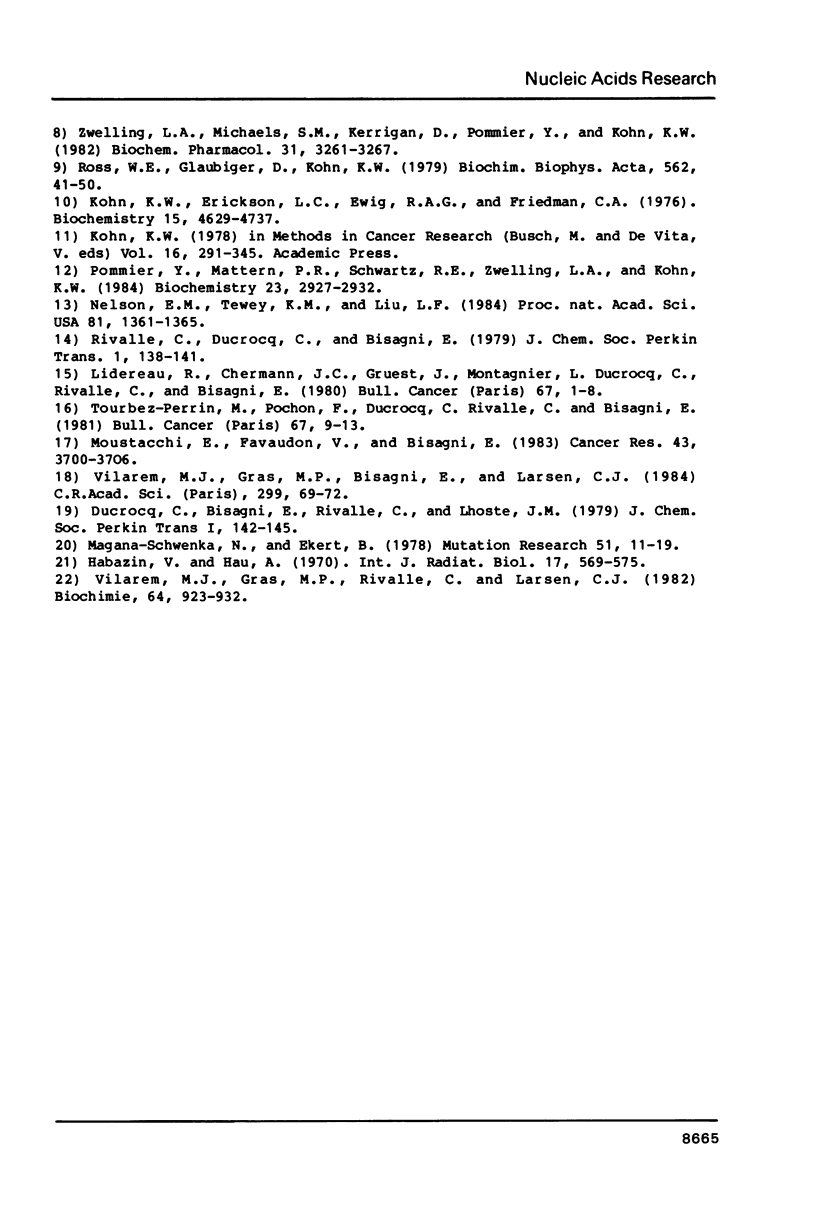Abstract
The ability of BD-40, a DNA intercalative Ellipticine analogue, to induce DNA protein-cross links (DPLs) in mammalian cell DNA was studied by measuring DNA extractability with 0.5M KCl. Like Ellipticine, BD-40 was found to decrease the extractability of DNA, indicating the presence of DPLs, at inhibitory doses as well as at cytotoxic doses. Further analysis by alkaline sucrose gradient sedimentation of BD-40-induced DLPs indicated that the apparent size of DNA was not modified in comparison to that of control cell DNA. Abolition of DPLs by a prior proteinase K treatment of nuclear lysates resulted in DNA size reduction revealing the existence of hidden DNA strand breaks. In contrast, no proteolytic treatment was required to obtain a similar size reduction of DNA from Ellipticine-treated cells. These data suggest that BD-40 induced DPLs involve NaDodSO4+alkali-resistant DNA strand-protein bridges which maintain cohesiveness of adjacent DNA termini. Thus, BD-40 appears to be different from other DPL-inducing intercalative agents which have not been reported to induce DNA-protein bridges.
Full text
PDF












Selected References
These references are in PubMed. This may not be the complete list of references from this article.
- Furlong N. B., Sato J., Brown T., Chavez F., Hurlbert R. B. Induction of limited DNA damage by the antitumor agent Cain's acridine. Cancer Res. 1978 May;38(5):1329–1335. [PubMed] [Google Scholar]
- Habazin V., Han A. Ultra-violet-light-induced DNA-to-protein cross-linking in HeLa cells. Int J Radiat Biol Relat Stud Phys Chem Med. 1970;17(6):569–575. doi: 10.1080/09553007014550711. [DOI] [PubMed] [Google Scholar]
- Kohn K. W., Erickson L. C., Ewig R. A., Friedman C. A. Fractionation of DNA from mammalian cells by alkaline elution. Biochemistry. 1976 Oct 19;15(21):4629–4637. doi: 10.1021/bi00666a013. [DOI] [PubMed] [Google Scholar]
- Lee Y. C., Byfield J. E. Induction of DNA degradation in vivo by adriamycin. J Natl Cancer Inst. 1976 Jul;57(1):221–224. doi: 10.1093/jnci/57.1.221. [DOI] [PubMed] [Google Scholar]
- Magana-Schwencke N., Ekert B. Biochemical analysis of damage induced in yeast by formaldehyde. II. Induction of cross-links between DNA and protein. Mutat Res. 1978 Jul;51(1):11–19. doi: 10.1016/0027-5107(78)90003-9. [DOI] [PubMed] [Google Scholar]
- Moustacchi E., Favaudon V., Bisagni E. Likelihood of the new antitumoral drug 10-[gamma-diethylaminopropylamino]-6-methyl-5H-pyrido[3',4':4,5]pyrrolo [2,3-g]isoquinoline (BD-40), a pyridopyrroloisoquinoline derivative, to induce DNA strand breaks in vivo and its nonmutagenicity in yeast. Cancer Res. 1983 Aug;43(8):3700–3706. [PubMed] [Google Scholar]
- Nelson E. M., Tewey K. M., Liu L. F. Mechanism of antitumor drug action: poisoning of mammalian DNA topoisomerase II on DNA by 4'-(9-acridinylamino)-methanesulfon-m-anisidide. Proc Natl Acad Sci U S A. 1984 Mar;81(5):1361–1365. doi: 10.1073/pnas.81.5.1361. [DOI] [PMC free article] [PubMed] [Google Scholar]
- Paoletti C., Lesca C., Cros S., Malvy C., Auclair C. Ellipticine and derivatives induce breakage of L1210 cells DNA in vitro. Biochem Pharmacol. 1979;28(3):345–350. doi: 10.1016/0006-2952(79)90096-0. [DOI] [PubMed] [Google Scholar]
- Pommier Y., Mattern M. R., Schwartz R. E., Zwelling L. A., Kohn K. W. Changes in deoxyribonucleic acid linking number due to treatment of mammalian cells with the intercalating agent 4'-(9-acridinylamino)methanesulfon-m-anisidide. Biochemistry. 1984 Jun 19;23(13):2927–2932. doi: 10.1021/bi00308a012. [DOI] [PubMed] [Google Scholar]
- Ross W. E., Bradley M. O. DNA double-stranded breaks in mammalian cells after exposure to intercalating agents. Biochim Biophys Acta. 1981 Jun 26;654(1):129–134. doi: 10.1016/0005-2787(81)90145-3. [DOI] [PubMed] [Google Scholar]
- Ross W. E., Glaubiger D. L., Kohn K. W. Protein-associated DNA breaks in cells treated with adriamycin or ellipticine. Biochim Biophys Acta. 1978 Jun 22;519(1):23–30. doi: 10.1016/0005-2787(78)90059-x. [DOI] [PubMed] [Google Scholar]
- Ross W. E., Glaubiger D., Kohn K. W. Qualitative and quantitative aspects of intercalator-induced DNA strand breaks. Biochim Biophys Acta. 1979 Mar 28;562(1):41–50. doi: 10.1016/0005-2787(79)90124-2. [DOI] [PubMed] [Google Scholar]
- Schwartz H. S. DNA breaks in P288 tumor cells in mice after treatment with daunorubicin and adriamycin. Res Commun Chem Pathol Pharmacol. 1975 Jan;10(1):51–64. [PubMed] [Google Scholar]
- Tourbez-Perrin M., Pochon F., Ducrocq C., Rivalle C., Bisagni E. Intercalative binding to DNA of new antitumoral agents: dipyrido [4,3-b] [3,4-f] indoles. Bull Cancer. 1980;67(1):9–13. [PubMed] [Google Scholar]
- Vilarem M. J., Gras M. P., Bisagni E., Larsen C. J. Le BD-40, intercalant dérivé des aza-9 ellipticines, induit dans l'ADN cellulaire des cassures associées à des pontages protéiques. C R Acad Sci III. 1984;299(4):69–72. [PubMed] [Google Scholar]
- Vilarem M. J., Gras M. P., Rivalle C., Larsen C. J. Possible relationship between pyrido-pyrrolo-isoquinoline derivative (BD-40) cell uptake and cell viability. Biochimie. 1982 Oct;64(10):923–932. doi: 10.1016/s0300-9084(82)80355-6. [DOI] [PubMed] [Google Scholar]
- Zwelling L. A., Michaels S., Erickson L. C., Ungerleider R. S., Nichols M., Kohn K. W. Protein-associated deoxyribonucleic acid strand breaks in L1210 cells treated with the deoxyribonucleic acid intercalating agents 4'-(9-acridinylamino) methanesulfon-m-anisidide and adriamycin. Biochemistry. 1981 Nov 10;20(23):6553–6563. doi: 10.1021/bi00526a006. [DOI] [PubMed] [Google Scholar]
- Zwelling L. A., Michaels S., Kerrigan D., Pommier Y., Kohn K. W. Protein-associated deoxyribonucleic acid strand breaks produced in mouse leukemia L1210 cells by ellipticine and 2-methyl-9-hydroxyellipticinium. Biochem Pharmacol. 1982 Oct 15;31(20):3261–3267. doi: 10.1016/0006-2952(82)90560-3. [DOI] [PubMed] [Google Scholar]


